
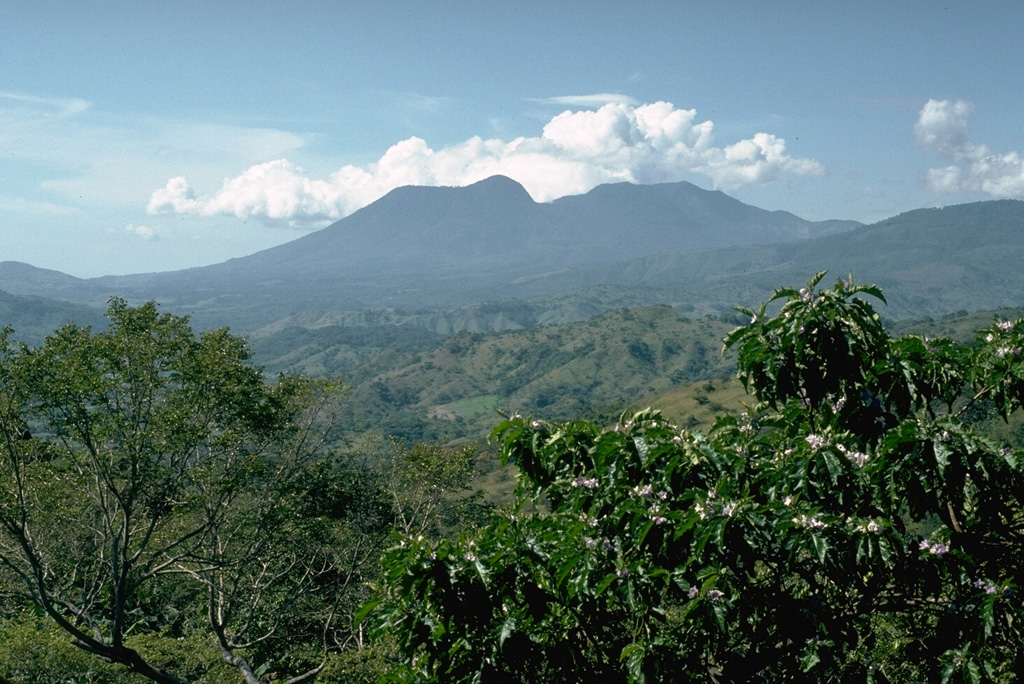
The Global Volcanism Program has no activity reports available for Tecuamburro.
The Global Volcanism Program has no Weekly Reports available for Tecuamburro.
The Global Volcanism Program has no Bulletin Reports available for Tecuamburro.
This compilation of synonyms and subsidiary features may not be comprehensive. Features are organized into four major categories: Cones, Craters, Domes, and Thermal Features. Synonyms of features appear indented below the primary name. In some cases additional feature type, elevation, or location details are provided.
Cones |
||||
| Feature Name | Feature Type | Elevation | Latitude | Longitude |
| Ixpaco, Laguna | Tuff ring | 1110 m | 14° 11' 28" N | 90° 25' 30" W |
| Miraflores | Stratovolcano | 1945 m | 14° 9' 25" N | 90° 25' 59" W |
| Perla, La | Stratovolcano | 14° 10' 0" N | 90° 25' 0" W | |
Craters |
||||
| Feature Name | Feature Type | Elevation | Latitude | Longitude |
| Chupadero | Crater | 1110 m | 14° 12' 0" N | 90° 26' 0" W |
Domes |
||||
| Feature Name | Feature Type | Elevation | Latitude | Longitude |
| Peña Blanca, Cerro | Dome | 1840 m | 14° 9' 40" N | 90° 25' 0" W |
| San Francisco | Dome | 1555 m | 14° 9' 0" N | 90° 25' 0" W |
| Soledad, Cerro la | Dome | 1845 m | 14° 9' 22" N | 90° 24' 25" W |
Thermal |
||||
| Feature Name | Feature Type | Elevation | Latitude | Longitude |
| Azufral | Thermal | 1440 m | 14° 9' 7" N | 90° 24' 50" W |
|
|
||||||||||||||||||||||||||||
There is data available for 1 confirmed Holocene eruptive periods.
0960 BCE ± 75 years Confirmed Eruption
| Episode 1 | Eruption | NW flank (Ixpaco Crater) | |||||||||||||||||||
|---|---|---|---|---|---|---|---|---|---|---|---|---|---|---|---|---|---|---|---|---|
| 0960 BCE ± 75 years - Unknown | Evidence from Isotopic: 14C (uncalibrated) | |||||||||||||||||||
|
List of 2 Events for Episode 1 at NW flank (Ixpaco Crater)
| ||||||||||||||||||||
There is no Deformation History data available for Tecuamburro.
There is no Emissions History data available for Tecuamburro.
 Tecuamburro, seen here from the north, is a small lava dome complex of mostly Pleistocene age. The smoother left flank consists of younger lava domes that were constructed during the late Pleistocene or early Holocene within a horseshoe-shaped, east-facing scarp. The scar resulted from structural failure of the older Miraflores edifice (right).
Tecuamburro, seen here from the north, is a small lava dome complex of mostly Pleistocene age. The smoother left flank consists of younger lava domes that were constructed during the late Pleistocene or early Holocene within a horseshoe-shaped, east-facing scarp. The scar resulted from structural failure of the older Miraflores edifice (right).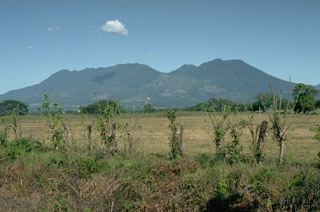 Tecuamburro, seen here from the SE on the Pacific coastal plain, is a small lava-dome complex of mostly Pleistocene age. Tecuamburro and other lava domes forming the right-hand peaks were constructed during the late Pleistocene or early Holocene within a horseshoe-shaped, east-facing crater. The crater resulted from structural failure of the older Miraflores stratovolcano on the left.
Tecuamburro, seen here from the SE on the Pacific coastal plain, is a small lava-dome complex of mostly Pleistocene age. Tecuamburro and other lava domes forming the right-hand peaks were constructed during the late Pleistocene or early Holocene within a horseshoe-shaped, east-facing crater. The crater resulted from structural failure of the older Miraflores stratovolcano on the left.  The low ridge on the left-hand horizon is the southern rim of a large horseshoe-shaped crater left by collapse of Miraflores, an ancestral edifice of the Tecuamburro volcanic complex. Miraflores formed about 100,000 years ago and collapsed sometime prior to 38,000 years ago. The vegetated peak to the right is part of the Tecuamburro lava dome complex, which formed within the scarp.
The low ridge on the left-hand horizon is the southern rim of a large horseshoe-shaped crater left by collapse of Miraflores, an ancestral edifice of the Tecuamburro volcanic complex. Miraflores formed about 100,000 years ago and collapsed sometime prior to 38,000 years ago. The vegetated peak to the right is part of the Tecuamburro lava dome complex, which formed within the scarp. The summit lava dome complex of Tecuamburro is seen here from the NE along the road from Cuilapa. Four adjacent NW-SE-trending lava domes, the SE-most (left-center) of which is Tecuamburro proper, were erupted within a large horseshoe-shaped scar left by collapse of an ancestral edifice. These domes erupted less than 38,000 years ago. The Tecuamburro complex was constructed within a 20-km-wide graben whose northern margin terminates against the major regional Jalpatagua fault.
The summit lava dome complex of Tecuamburro is seen here from the NE along the road from Cuilapa. Four adjacent NW-SE-trending lava domes, the SE-most (left-center) of which is Tecuamburro proper, were erupted within a large horseshoe-shaped scar left by collapse of an ancestral edifice. These domes erupted less than 38,000 years ago. The Tecuamburro complex was constructed within a 20-km-wide graben whose northern margin terminates against the major regional Jalpatagua fault.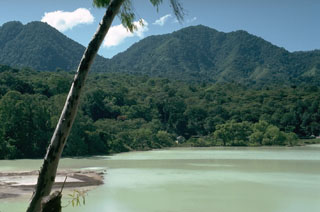 Ixpaco crater is a 1-km-wide maar on the NW flank of Tecuamburro that formed during an explosive eruption about 2,900 years ago. An acidic lake fills the maar, and fumaroles, acid-sulfate hot springs, and mud pools occur around the lake. Colloidal sulfur turns the lake a milky green color. This view is from the north with the forested lava domes of Cerro Miraflores (left) and Cerro Pena Blanca (right) in the background.
Ixpaco crater is a 1-km-wide maar on the NW flank of Tecuamburro that formed during an explosive eruption about 2,900 years ago. An acidic lake fills the maar, and fumaroles, acid-sulfate hot springs, and mud pools occur around the lake. Colloidal sulfur turns the lake a milky green color. This view is from the north with the forested lava domes of Cerro Miraflores (left) and Cerro Pena Blanca (right) in the background.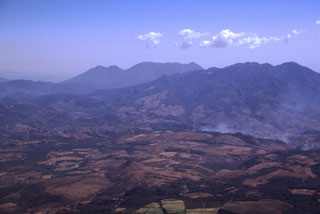 The deeply eroded Plio-Pleistocene stratovolcano at the upper right is Pueblo Nuevo Viñas (also known as Cerro la Gabia). Four scoria cones are located on the NE flank, and lava flows from the volcano cover the western portion of the Cuilapa quadrangle. This view is from the NW at the summit of Pacaya volcano with Tecuamburro volcano on the center horizon. Flank activity from Tecuamburro has occurred as recently as about 3,000 years ago.
The deeply eroded Plio-Pleistocene stratovolcano at the upper right is Pueblo Nuevo Viñas (also known as Cerro la Gabia). Four scoria cones are located on the NE flank, and lava flows from the volcano cover the western portion of the Cuilapa quadrangle. This view is from the NW at the summit of Pacaya volcano with Tecuamburro volcano on the center horizon. Flank activity from Tecuamburro has occurred as recently as about 3,000 years ago.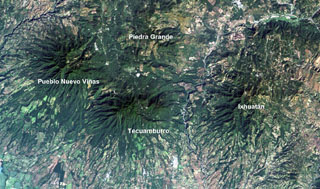 Four large Pleistocene volcanic complexes are visible in this Landsat image of southern Guatemala, with the Pacific coastal plain at the bottom. Minor activity at Tecuamburro volcano continued into the Holocene at Laguna Ixpaco, the small circular white dot a little more than half-way between the Tecuamburro and Piedra Grande labels. The Río los Esclavos extends from the upper right, cutting between Tecuamburro and Ixhuatán volcanoes.
Four large Pleistocene volcanic complexes are visible in this Landsat image of southern Guatemala, with the Pacific coastal plain at the bottom. Minor activity at Tecuamburro volcano continued into the Holocene at Laguna Ixpaco, the small circular white dot a little more than half-way between the Tecuamburro and Piedra Grande labels. The Río los Esclavos extends from the upper right, cutting between Tecuamburro and Ixhuatán volcanoes. The Tecuamburro volcanic complex has a diverse history. Collapse of the ancestral Pleistocene Miraflores edifice underwent collapse, producing an avalanche deposit that traveled across the Río los Esclavos (right) and forming a large horseshoe-shaped crater open to the east. The modern Tecuamburro complex, consisting of four lava domes, was constructed within this scarp. The Laguna Ixpaco crater was created about 2,900 years ago within the much larger Pleistocene Chupadero crater.
The Tecuamburro volcanic complex has a diverse history. Collapse of the ancestral Pleistocene Miraflores edifice underwent collapse, producing an avalanche deposit that traveled across the Río los Esclavos (right) and forming a large horseshoe-shaped crater open to the east. The modern Tecuamburro complex, consisting of four lava domes, was constructed within this scarp. The Laguna Ixpaco crater was created about 2,900 years ago within the much larger Pleistocene Chupadero crater.Maps are not currently available due to technical issues.
There are no samples for Tecuamburro in the Smithsonian's NMNH Department of Mineral Sciences Rock and Ore collection.
| Copernicus Browser | The Copernicus Browser replaced the Sentinel Hub Playground browser in 2023, to provide access to Earth observation archives from the Copernicus Data Space Ecosystem, the main distribution platform for data from the EU Copernicus missions. |
| MIROVA | Middle InfraRed Observation of Volcanic Activity (MIROVA) is a near real time volcanic hot-spot detection system based on the analysis of MODIS (Moderate Resolution Imaging Spectroradiometer) data. In particular, MIROVA uses the Middle InfraRed Radiation (MIR), measured over target volcanoes, in order to detect, locate and measure the heat radiation sourced from volcanic activity. |
| MODVOLC Thermal Alerts | Using infrared satellite Moderate Resolution Imaging Spectroradiometer (MODIS) data, scientists at the Hawai'i Institute of Geophysics and Planetology, University of Hawai'i, developed an automated system called MODVOLC to map thermal hot-spots in near real time. For each MODIS image, the algorithm automatically scans each 1 km pixel within it to check for high-temperature hot-spots. When one is found the date, time, location, and intensity are recorded. MODIS looks at every square km of the Earth every 48 hours, once during the day and once during the night, and the presence of two MODIS sensors in space allows at least four hot-spot observations every two days. Each day updated global maps are compiled to display the locations of all hot spots detected in the previous 24 hours. There is a drop-down list with volcano names which allow users to 'zoom-in' and examine the distribution of hot-spots at a variety of spatial scales. |
|
WOVOdat
Single Volcano View Temporal Evolution of Unrest Side by Side Volcanoes |
WOVOdat is a database of volcanic unrest; instrumentally and visually recorded changes in seismicity, ground deformation, gas emission, and other parameters from their normal baselines. It is sponsored by the World Organization of Volcano Observatories (WOVO) and presently hosted at the Earth Observatory of Singapore.
GVMID Data on Volcano Monitoring Infrastructure The Global Volcano Monitoring Infrastructure Database GVMID, is aimed at documenting and improving capabilities of volcano monitoring from the ground and space. GVMID should provide a snapshot and baseline view of the techniques and instrumentation that are in place at various volcanoes, which can be use by volcano observatories as reference to setup new monitoring system or improving networks at a specific volcano. These data will allow identification of what monitoring gaps exist, which can be then targeted by remote sensing infrastructure and future instrument deployments. |
| Volcanic Hazard Maps | The IAVCEI Commission on Volcanic Hazards and Risk has a Volcanic Hazard Maps database designed to serve as a resource for hazard mappers (or other interested parties) to explore how common issues in hazard map development have been addressed at different volcanoes, in different countries, for different hazards, and for different intended audiences. In addition to the comprehensive, searchable Volcanic Hazard Maps Database, this website contains information about diversity of volcanic hazard maps, illustrated using examples from the database. This site is for educational purposes related to volcanic hazard maps. Hazard maps found on this website should not be used for emergency purposes. For the most recent, official hazard map for a particular volcano, please seek out the proper institutional authorities on the matter. |
| IRIS seismic stations/networks | Incorporated Research Institutions for Seismology (IRIS) Data Services map showing the location of seismic stations from all available networks (permanent or temporary) within a radius of 0.18° (about 20 km at mid-latitudes) from the given location of Tecuamburro. Users can customize a variety of filters and options in the left panel. Note that if there are no stations are known the map will default to show the entire world with a "No data matched request" error notice. |
| UNAVCO GPS/GNSS stations | Geodetic Data Services map from UNAVCO showing the location of GPS/GNSS stations from all available networks (permanent or temporary) within a radius of 20 km from the given location of Tecuamburro. Users can customize the data search based on station or network names, location, and time window. Requires Adobe Flash Player. |
| DECADE Data | The DECADE portal, still in the developmental stage, serves as an example of the proposed interoperability between The Smithsonian Institution's Global Volcanism Program, the Mapping Gas Emissions (MaGa) Database, and the EarthChem Geochemical Portal. The Deep Earth Carbon Degassing (DECADE) initiative seeks to use new and established technologies to determine accurate global fluxes of volcanic CO2 to the atmosphere, but installing CO2 monitoring networks on 20 of the world's 150 most actively degassing volcanoes. The group uses related laboratory-based studies (direct gas sampling and analysis, melt inclusions) to provide new data for direct degassing of deep earth carbon to the atmosphere. |
| Large Eruptions of Tecuamburro | Information about large Quaternary eruptions (VEI >= 4) is cataloged in the Large Magnitude Explosive Volcanic Eruptions (LaMEVE) database of the Volcano Global Risk Identification and Analysis Project (VOGRIPA). |
| EarthChem | EarthChem develops and maintains databases, software, and services that support the preservation, discovery, access and analysis of geochemical data, and facilitate their integration with the broad array of other available earth science parameters. EarthChem is operated by a joint team of disciplinary scientists, data scientists, data managers and information technology developers who are part of the NSF-funded data facility Integrated Earth Data Applications (IEDA). IEDA is a collaborative effort of EarthChem and the Marine Geoscience Data System (MGDS). |